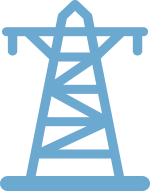Our research shapes your future

Innovation with Universities and Specialists

Model-Predictive Wind Turbine Control (MPWTC) | W2E is one of the first companies worldwide conducting a field test with Model-Predictive Wind Turbine Control (MPWTC) in 2020. Since 2014 W2E is doing research on that topic with the very renowned Institute of Automatic Control of the RWTH Aachen University. The aim of the project is to develop the Wind Turbine Control of the future. Several projects has done by funding of the German Federal Ministry for Economic Affairs and Energy and German Federal Ministry for Education and Research, e.g. 01IS17015A/B.
A wind turbine has only two actuating variables, blade angle velocity and generator torque, but numerous competitive control variables, such as power output, load reduction, power quality and so on. The aim of this projects is to develop a control system being able to find the optimal solution for this multi-criteria optimisation problem. Additionally, an Inertial Measurement Unit (IMU) based Individual Pitch Control (IPC) system has been developed.
- Kallen, T.; Zierath, J.; Dickler, S.; Konrad, T.; Jassmann, U.; Abel, D.: Repetitive Individual Pitch Control for Load Alleviation at Variable Rotor Speed, In Proceedings of the EAWE’s Science of Making Torque from Wind (TORQUE) Conference, Delft, The Netherlands, 2020. https://doi.org/10.1088/1742-6596/1618/2/022055
- Dickler, S.; Kallen, T.; Zierath, J.; Abel, D.: Rapid Control Prototyping of Model Predictive Wind Turbine Control Towards Field Testing, In Proceedings of the EAWE’s Science of Making Torque from Wind (TORQUE) Conference, Delft, The Netherlands, 2020. https://doi.org/10.1088/1742-6596/1618/2/022068
- Jassmann, U.; Dickler, S.; Zierath, J.; Abel, D.: Model Predictive Wind Turbine Control with Move-Blocking Strategy for Load Alleviation and Power Leveling. In Journal of Physics: Conference Series 753(5), pp. 052021, from TORQUE 2016 „The Science from Making Torque of Wind“, Munich, Germany, 2016. https://doi.org/10.1088/1742-6596/753/5/052021

Structural Health Monitoring for Lifetime Extension of Wind Turbines | Lifetime extension is an ongoing topic in wind industry. Since 2019 W2E challenges this problem by the development of a Structural Health Monitoring (SHM) system using a minimal number of sensors. The planned SHM system will be able to provide the remaining lifetime of wind turbine structural components based on its actual fatigue behaviour. The research project DynAWind² in cooperation with the Chairs of Technical Dynamics and Structural Mechanics of the University of Rostock as well as WINDnovation Engineering Solutions is funded by the German Federal Ministry for Economic Affairs and Energy under the grant number 0325228E/F/G.
Technical goals of the project are to develop a model-based state estimator of the wind turbine to predict the actual deformation behaviour of the structural components in combination with the development of a fatigue law for fibre-reinforced composites. First results of the research project are summarised in
- Zierath, J.; Luthe, J.; Schulze, A.; Rosenow, S.-E.; Saalbach, C.; Sander, M.; Woernle, C.: Structural Fatigue Monitoring Concept for Wind Turbines by Means of Digital Twins, In Proceedings of the International Modal Analysis Conference (IMAC), Houston, Texas, 2020. https://www.springer.com/gp/book/9783030487782#
- Luthe, J.; Schulze, A.; Zierath, J.; Rosenow, S.-E.; Woernle, C.: A Concept for the Estimation of Displacement Fields in Flexible Wind Turbine Structures, In Proceedings of the International Modal Analysis Conference (IMAC), Houston, Texas, 2020. https://www.springer.com/gp/book/9783030477165

Multibody System Dynamics | By increasing size of wind turbines, the dynamic behaviour is getting more complex. Thus, simple calculation codes are not sufficient enough to simulate the exact aeroelastic behaviour of wind turbines. W2E takes care on this development and started in 2010 in cooperation with the Chair of Technical Dynamics of the University of Rostock a research project to find the best aeroelastic simulation tool of for wind turbines. The project has been funded by the German Federal Ministry for Economic Affairs and Energy under the grant number 0325228A/B.
W2E decided to introduce general-purpose Multibody simulation tools instead of extending the simple simulation codes such as FLEX5 to have a future-proof dynamic simulation tool for the wind turbine development. The general-purpose Multibody simulation tools that has been used are
W2E has extended the simulations tools by renowned aerodynamic codes such as NREL’s AeroDyn and the original controller algorithms to simulate reality. One aim of this project was to provide a full field-test validation according to the IEC 61400-13 standard. The results have been summarised in
- Zierath J., Rachholz R., Woernle C. (2014) Comparison and Field Test Validation of Various Multibody Codes for Wind Turbine Modelling. In: Terze Z. (eds) Multibody Dynamics. Computational Methods in Applied Sciences, vol 35. Springer, Cham. https://doi.org/10.1007/978-3-319-07260-9_13
- Zierath, J.; Rachholz, R.; Woernle, C.; Müller, A.: Load Calculation on Wind Turbines: Validation of Flex5, alaska/Wind, MSC.Adams and SIMPACK by means of Field Tests, In Proceedings of the ASME 2014 International Design Engineering Technical Conferences & Computers and Information in Engineering Conference, 2nd Biennial International Conference on Dynamics for Design (DFD), Buffalo, New York, USA, 2014, paper No. DETC2014-34670. https://doi.org/10.1115/DETC2014-34670
- Zierath, J.; Rachholz, R.; Woernle, C.: Field Test Validation of Flex5, MSC.Adams, alaska/Wind and SIMPACK for Load Calculations on Wind Turbines, In Wind Energy 19:1201-1222, John Wiley & Sons, West Sussex, England, 2016. https://doi.org/10.1002/we.1892

Grid Supporting Wind Turbines | The energy transition leads to increasing demands to wind turbines to support the stability of the grids. W2E cooperates in that project with the Institute for Electrical Power Engineering of the University of Rostock. Within a first research project advanced converter topologies with an increased fault tolerance has been developed. The research has been funded by the German Federal Ministry for Economic Affairs and Energy under the grant number 0325789A/B. A second research project on grid supporting converter technologies will start in 2021.
- Hein, Y.; Gierschner, S.; Hammes, D.; Kayser, F.; Eckel, H.-G.; Zierath, J.; Krug, D.: Reduction of negative effects of a short circuit through improved converter topology for wind energy applications, In Proceedings of EPE 2018 ECCE EUROPE, 20th EUROPEAN CONFERENCE ON POWER ELECTRONICS AND APPLICATIONS, Riga, Latvia, 2018.

Experimental and Operational Modal Analysis | The basis of designing a wind turbine is an extensive understanding of its fundamental structural dynamic behaviour. As larger a wind turbine is its dynamic effects gets more dominant with respect to its fatigue behaviour. The research project DynAWind in cooperation with the Chair of Technical Dynamics of the University of Rostock has the goal to provide methods how to numerically and experimentally analyse the dynamic behaviour of wind turbines. The project has been funded by the German Federal Ministry for Economic Affairs and Energy under the grant number 0325228C/D.
The aim of the project is to analyse the wind turbines experimentally during operation to understand the oscillation behaviour and interaction between large structural components such as blades and tower. W2E was one of the first developers using micromechanical Inertial Measurement Units to investigate their turbines experimentally. Results of this research project has been summarised in
- Schulze, A.; Zierath, J.; Rosenow, S.-E.; Bockhahn, R.; Rachholz, R.; Woernle, C.: Optimal Sensor Placement for Modal Testing on Wind Turbines. In Journal of Physics: Conference Series 753(7), pp. 072031, from TORQUE 2016 „The Science from Making Torque of Wind“, Munich, Germany, 2016. https://doi.org/10.1088/1742-6596/753/7/072031
- Zierath, J.; Rachholz, R.; Rosenow, S.-E.; Bockhahn, R.; Schulze, A.; Woernle, C.: Experimental Identification of Modal Parameters of an Industrial 2 MW Wind Turbine. In Wind Energy 21: 338-356, John Wiley & Sons, West Sussex, England, 2018. https://doi.org/10.1002/we.2165









